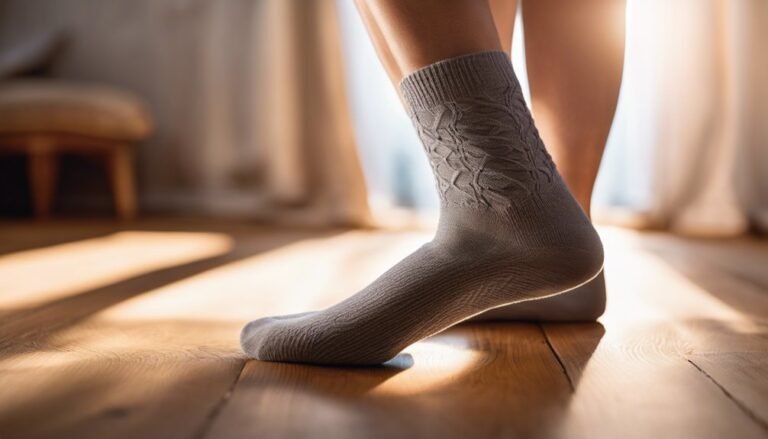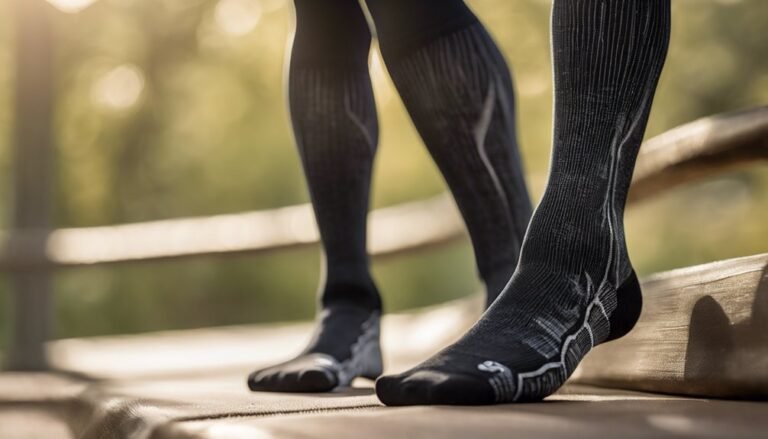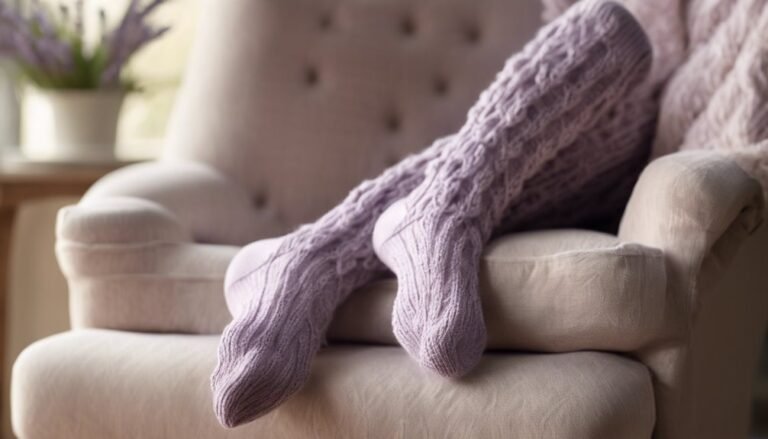The Best Socks for Preventing Frostbite in Winter
To prevent frostbite in winter, you need socks that offer insulation, moisture-wicking properties, and durability. Look for thicker socks made from materials like merino wool for excellent warmth retention and synthetic options for quick drying. Make certain they fit snugly without restricting circulation. Brands like Smartwool and Darn Tough provide high-quality options designed for extreme cold. Remember, layering your socks can enhance warmth further. Explore additional tips to keep your feet safe and comfortable in harsh conditions.
Understanding Frostbite and Its Risks

When temperatures drop, understanding frostbite and its associated risks becomes vital for anyone venturing outdoors. Frostbite occurs when skin and underlying tissues freeze, commonly affecting extremities like fingers and toes. Recognizing frostbite symptoms is important: initial signs include redness, tingling, and numbness, while advanced stages can lead to bluish or gray skin and loss of sensation. To guarantee frostbite prevention, dress in layers, prioritizing moisture-wicking materials that keep your skin dry. Invest in high-quality winter socks that provide insulation and fit snugly without restricting circulation. Regularly check your extremities for early signs of frostbite, and don't hesitate to seek warmth if you notice any symptoms. Being proactive can keep you safe and allow you to enjoy your winter adventures freely.
Key Features to Look for in Winter Socks
To effectively prevent frostbite, it is essential to choose winter socks with specific features that enhance warmth and comfort. First, consider sock thickness; thicker socks generally provide better insulation, creating a barrier against the cold. However, you don't want them so thick that they restrict circulation. Next, examine thermal ratings; these indicate how well a sock can retain heat. Look for socks with higher thermal ratings, as they're designed for extreme temperatures. Additionally, make sure the socks have moisture-wicking capabilities to keep your feet dry, as dampness can lead to chilling and frostbite. Finally, opt for socks with cushioning for added comfort during extended wear, especially if you're active outdoors. Prioritizing these features can help you stay warm and safe this winter.
Top Materials for Insulating Socks
Choosing the right materials for insulating socks is essential for maintaining warmth and comfort in frigid conditions. When considering wool vs. synthetic options, both have their merits. Wool, particularly merino, excels in insulation effectiveness due to its natural ability to trap heat while also managing moisture. It provides warmth even when damp, making it a top choice for extreme cold. On the other hand, synthetic materials like polyester and nylon offer excellent thermal insulation and are often lighter and quicker to dry. They can be engineered for ideal breathability and durability, but may not match wool's natural insulation properties. Ultimately, your choice depends on your specific needs and the conditions you'll face. Prioritize materials that keep you warm and comfortable during your winter adventures.
The Importance of Moisture-Wicking Technology
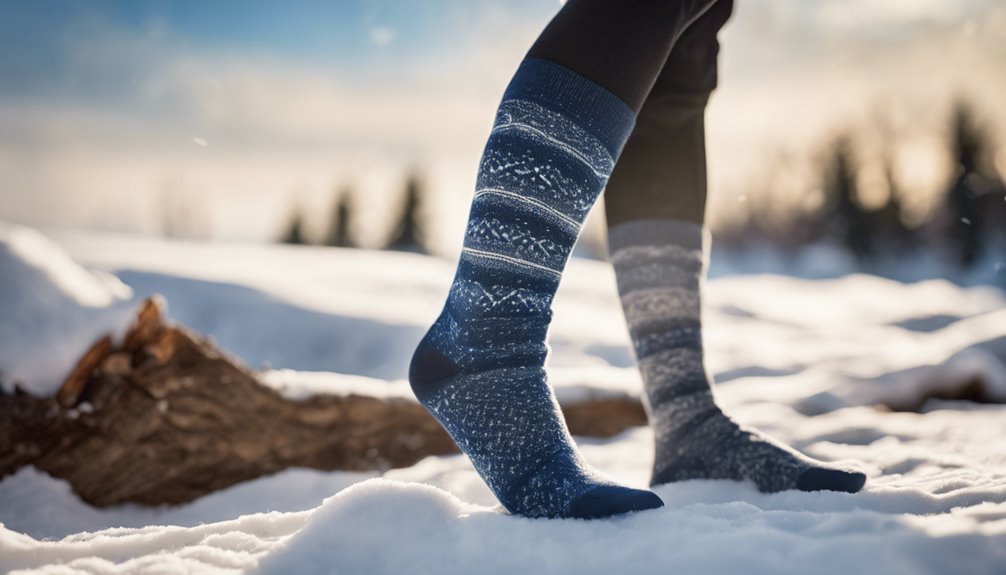
Although cold temperatures pose a significant risk for frostbite, moisture-wicking technology in socks can play an important role in preventing this condition. This technology effectively manages moisture retention, ensuring that sweat is drawn away from your skin. When moisture accumulates, it can lead to chilling and increase your risk of frostbite. By keeping your feet dry, these socks help maintain ideal temperature regulation, allowing your body to focus on staying warm rather than expending energy to combat dampness. Additionally, moisture-wicking materials often dry quickly, enhancing comfort during prolonged exposure to cold conditions. Choosing socks with this feature is vital for ensuring that your feet remain warm, dry, and protected throughout winter activities, allowing you to embrace the freedom of the outdoors.
Best Thermal Socks for Extreme Cold
When temperatures plunge and you venture into extreme cold, selecting the right thermal socks becomes vital for maintaining warmth and preventing frostbite. Look for thermal sock features such as heavy insulation, moisture-wicking materials, and extra cushioning. These components work together to trap heat while keeping your feet dry, which is paramount in harsh conditions.
The extreme cold benefits of proper thermal socks include enhanced blood circulation and reduced risk of cold-related injuries. Additionally, consider socks with a snug fit to minimize heat loss and prevent uncomfortable bunching. Investing in high-quality thermal socks guarantees you can enjoy winter activities without sacrificing comfort or safety. Choose wisely, and your feet will thank you as you embrace the freedom to explore.
Lightweight vs. Heavyweight Socks: What's Right for You?
When choosing between lightweight and heavyweight socks, consider how insulation and warmth will impact your comfort in cold conditions. Lightweight socks often excel in moisture management, keeping your feet dry and reducing the risk of frostbite, while heavyweight socks provide superior insulation for extreme cold. Assess your activity level and the environment to determine which option best suits your needs.
Insulation and Warmth
Choosing the right socks for winter activities can greatly impact your comfort and safety, especially when it comes to preventing frostbite. When considering insulation types, it's crucial to weigh the warmth factors of lightweight versus heavyweight socks.
- Lightweight socks are ideal for milder conditions, offering breathability and flexibility.
- Heavyweight socks provide superior insulation, perfect for extreme cold, but may limit mobility.
- Consider your activity level; high-intensity activities may require less insulation to avoid overheating.
Ultimately, your choice should align with the weather, your activity level, and personal comfort. Opting for the right sock can enhance your winter experience while keeping frostbite at bay.
Moisture Management Benefits
The effectiveness of socks in winter isn't just about warmth; moisture management plays an essential role in preventing frostbite. You need to take into account how different sock weights affect moisture control. Lightweight socks excel in breathability, allowing sweat to escape, which helps maintain temperature regulation. If you're active, they're often the better choice. On the other hand, heavyweight socks provide insulation but can trap moisture, potentially leading to cold feet if they don't wick moisture effectively. When choosing, think about your activity level and the conditions you'll face. By balancing moisture control and insulation, you can enjoy winter's freedom without risking frostbite. So, whether you prefer lightweight or heavyweight, prioritize socks that manage moisture effectively.
Recommended Brands for Winter Socks
Several brands consistently stand out for their quality winter socks designed to prevent frostbite and keep your feet warm in extreme conditions. When considering sock durability and making brand comparisons, you'll find a few that excel:
- Smartwool: Known for their merino wool blend, they offer excellent insulation and moisture-wicking properties.
- Darn Tough: With a lifetime guarantee, their socks are tough and comfortable, perfect for prolonged use in harsh conditions.
- Icebreaker: They focus on sustainable materials while providing warmth and breathability, making them a great choice for outdoor enthusiasts.
Sock Layering Techniques for Maximum Warmth
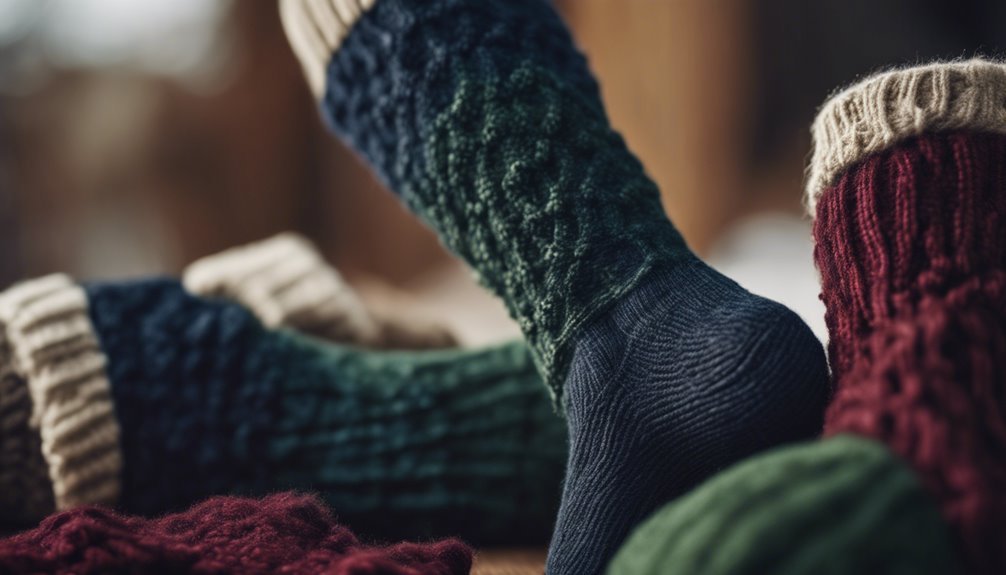
While you may think that a single pair of thick socks is sufficient for cold weather, employing a layering technique can considerably enhance warmth and comfort. Using effective sock combinations allows for better moisture management and insulation. Here are some practical layering strategies to keep your feet cozy:
| Layer Type | Material | Purpose |
|---|---|---|
| Base Layer | Merino Wool | Moisture-wicking |
| Mid Layer | Synthetic Blend | Insulation |
| Outer Layer | Thick Wool | Added warmth |
Start with a moisture-wicking base layer to keep your feet dry. Add an insulating mid layer for warmth, and finish with a thick outer sock for additional protection. This method not only improves comfort but also reduces the risk of frostbite.
Caring for Your Winter Socks
Caring for your winter socks is essential to maintain their effectiveness and longevity, especially when you rely on them to keep your feet warm in harsh conditions. To guarantee they serve you well, follow these guidelines:
- Proper washing: Use cold water and a gentle cycle to avoid damaging the fibers. Avoid fabric softeners, as they can reduce insulation.
- Sock storage: Store your socks in a cool, dry place. Avoid compressing them, as this can affect their shape and insulation properties.
- Inspect regularly: Check for any signs of wear or damage. Addressing small issues early can extend the life of your socks.
Real-Life Experiences: Testimonies From Winter Adventurers
When you're out in extreme cold, the right socks can make all the difference. Many winter adventurers have shared their personal journeys, highlighting sock choices that truly matter in preventing frostbite. Their lessons from the outdoors can guide you in selecting the best gear for your own winter excursions.
Personal Journeys in Cold
As temperatures plummet and winter adventures beckon, the risk of frostbite becomes a real concern for outdoor enthusiasts. Your personal experiences in cold adventures can offer valuable insights. Many adventurers have faced the harsh reality of freezing conditions, sharing tales of how they learned to respect the cold.
- Always test gear before venturing out.
- Keep moving to maintain blood circulation.
- Prioritize layering, especially with socks.
These shared journeys emphasize the importance of preparation and awareness. You'll find that understanding the cold, combined with practical strategies, can greatly reduce your risk of frostbite. Embrace the freedom of winter exploration while respecting its challenges, ensuring your adventures remain enjoyable and safe.
Sock Choices That Matter
Choosing the right socks can make a significant difference in your winter adventures, particularly when it comes to preventing frostbite. Many winter adventurers emphasize the importance of sock thickness and sock fit. Here's a quick overview of what they've found:
| Sock Thickness | Sock Fit |
|---|---|
| Thick – Offers insulation but may restrict circulation. | Snug – Prevents slippage and blisters. |
| Medium – Balances warmth and comfort. | Loose – Can lead to cold spots. |
| Thin – Best for active use in milder conditions. | Perfect Fit – Vital for prolonged exposure. |
Ultimately, choosing the right combination of thickness and fit is essential. It's about finding what works for you to stay warm and mobile in the harshest conditions.
Lessons From the Outdoors
While many winter adventurers focus on gear selection, real-life experiences often reveal the essential role that the right socks play in preventing frostbite. You might think it's all about boots and insulation, but countless outdoor survival stories highlight how improper sock choices led to painful consequences. For effective winter preparedness, consider these insights from fellow adventurers:
- Moisture Management: Opt for moisture-wicking materials to keep your feet dry.
- Layering Techniques: Experiment with thin liners under thicker socks for better insulation.
- Fit Matters: Make sure your socks aren't too tight; circulation is key to warmth.
Listening to these lessons can enhance your winter adventures while safeguarding against frostbite. Remember, your socks are just as crucial as any other piece of gear.
Frequently Asked Questions
How Do I Know if My Socks Fit Properly for Winter Activities?
To guarantee your socks fit properly for winter activities, check sock thickness and material types. They should snugly hug your feet without restricting circulation, allowing for insulation while maintaining comfort and freedom during movement.
Can I Use Regular Socks for Winter Hiking?
You can use regular socks for winter hiking, but they may lack proper insulation and moisture-wicking capabilities. Consider winter sock materials like merino wool, comparing thickness for ideal warmth and comfort during your outdoor adventures.
How Often Should I Replace My Winter Socks?
You should replace your winter socks every 6-12 months, depending on sock material and thickness. Worn-out socks can lose insulation and moisture-wicking properties, compromising comfort and performance during your cold-weather adventures.
Are There Specific Socks for Different Winter Sports?
Yes, there are specific socks designed for different winter sports. Ski socks offer cushioning and moisture-wicking, while snowboard socks provide extra warmth and padding. Choosing the right pair enhances comfort and performance during your activities.
How Do I Prevent Sock Odor in Winter?
Did you know that around 70% of sock odor comes from bacteria? To prevent it in winter, choose moisture-wicking sock materials and prioritize odor management features. Regular washing can also help maintain freshness and comfort.



